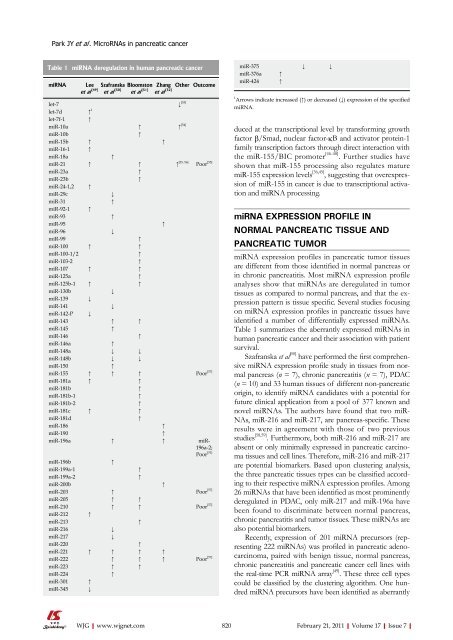Management of stage Ⅳ rectal cancer - World Journal of ...
Management of stage Ⅳ rectal cancer - World Journal of ...
Management of stage Ⅳ rectal cancer - World Journal of ...
Create successful ePaper yourself
Turn your PDF publications into a flip-book with our unique Google optimized e-Paper software.
Park JY et al . MicroRNAs in pancreatic <strong>cancer</strong><br />
Table 1 miRNA deregulation in human pancreatic <strong>cancer</strong><br />
miRNA Lee<br />
et al [49]<br />
Szafranska<br />
et al [50]<br />
Bloomston<br />
et al [51]<br />
Zhang<br />
et al [52]<br />
Other Outcome<br />
let-7 ↓ [53]<br />
let-7d ↑ 1<br />
let-7f-1 ↑<br />
miR-10a ↑ ↑ [54]<br />
miR-10b ↑<br />
miR-15b ↑ ↑<br />
miR-16-1 ↑<br />
miR-18a ↑<br />
miR-21 ↑ ↑<br />
[55, 56]<br />
↑ Poor [55]<br />
miR-23a ↑<br />
miR-23b ↑<br />
miR-24-1,2 ↑<br />
miR-29c ↓<br />
miR-31 ↑<br />
miR-92-1 ↑<br />
miR-93 ↑<br />
miR-95 ↑<br />
miR-96 ↓<br />
miR-99 ↑<br />
miR-100 ↑ ↑<br />
miR-100-1/2 ↑<br />
miR-103-2 ↑<br />
miR-107 ↑ ↑<br />
miR-125a ↑<br />
miR-125b-1 ↑ ↑<br />
miR-130b ↓<br />
miR-139 ↓<br />
miR-141 ↓<br />
miR-142-P ↓<br />
miR-143 ↑ ↑<br />
miR-145 ↑<br />
miR-146 ↑<br />
miR-146a ↑<br />
miR-148a ↓ ↓<br />
miR-148b ↓ ↓<br />
miR-150 ↑<br />
miR-155 ↑ ↑ ↑ Poor [57]<br />
miR-181a ↑ ↑<br />
miR-181b ↑<br />
miR-181b-1 ↑<br />
miR-181b-2 ↑<br />
miR-181c ↑ ↑<br />
miR-181d ↑<br />
miR-186 ↑<br />
miR-190 ↑<br />
miR-196a ↑ ↑ miR-<br />
196a-2;<br />
Poor [51]<br />
miR-196b ↑<br />
miR-199a-1 ↑<br />
miR-199a-2 ↑<br />
miR-200b ↑<br />
miR-203 ↑ Poor [57]<br />
miR-205 ↑ ↑<br />
miR-210 ↑ ↑ Poor [57]<br />
miR-212 ↑<br />
miR-213 ↑<br />
miR-216 ↓<br />
miR-217 ↓<br />
miR-220 ↑<br />
miR-221 ↑ ↑ ↑ ↑<br />
miR-222 ↑ ↑ ↑ Poor [57]<br />
miR-223 ↑ ↑<br />
miR-224 ↑<br />
miR-301 ↑<br />
miR-345 ↓<br />
WJG|www.wjgnet.com<br />
miR-375 ↓ ↓<br />
miR-376a ↑<br />
miR-424 ↑<br />
1 Arrows indicate increased (↑) or decreased (↓) expression <strong>of</strong> the specified<br />
miRNA.<br />
duced at the transcriptional level by transforming growth<br />
factor β/Smad, nuclear factor-κB and activator protein-1<br />
family transcription factors through direct interaction with<br />
the miR-155/BIC promoter [46-48] . Further studies have<br />
shown that miR-155 processing also regulates mature<br />
miR-155 expression levels [36,45] , suggesting that overexpression<br />
<strong>of</strong> miR-155 in <strong>cancer</strong> is due to transcriptional activation<br />
and miRNA processing.<br />
miRNA EXPRESSION PROFILE IN<br />
NORMAL PANCREATIC TISSUE AND<br />
PANCREATIC TUMOR<br />
miRNA expression pr<strong>of</strong>iles in pancreatic tumor tissues<br />
are different from those identified in normal pancreas or<br />
in chronic pancreatitis. Most miRNA expression pr<strong>of</strong>ile<br />
analyses show that miRNAs are deregulated in tumor<br />
tissues as compared to normal pancreas, and that the expression<br />
pattern is tissue specific. Several studies focusing<br />
on miRNA expression pr<strong>of</strong>iles in pancreatic tissues have<br />
identified a number <strong>of</strong> differentially expressed miRNAs.<br />
Table 1 summarizes the aberrantly expressed miRNAs in<br />
human pancreatic <strong>cancer</strong> and their association with patient<br />
survival.<br />
Szafranska et al [50] have performed the first comprehensive<br />
miRNA expression pr<strong>of</strong>ile study in tissues from normal<br />
pancreas (n = 7), chronic pancreatitis (n = 7), PDAC<br />
(n = 10) and 33 human tissues <strong>of</strong> different non-pancreatic<br />
origin, to identify miRNA candidates with a potential for<br />
future clinical application from a pool <strong>of</strong> 377 known and<br />
novel miRNAs. The authors have found that two miR-<br />
NAs, miR-216 and miR-217, are pancreas-specific. These<br />
results were in agreement with those <strong>of</strong> two previous<br />
studies [58,59] . Furthermore, both miR-216 and miR-217 are<br />
absent or only minimally expressed in pancreatic carcinoma<br />
tissues and cell lines. Therefore, miR-216 and miR-217<br />
are potential biomarkers. Based upon clustering analysis,<br />
the three pancreatic tissues types can be classified according<br />
to their respective miRNA expression pr<strong>of</strong>iles. Among<br />
26 miRNAs that have been identified as most prominently<br />
deregulated in PDAC, only miR-217 and miR-196a have<br />
been found to discriminate between normal pancreas,<br />
chronic pancreatitis and tumor tissues. These miRNAs are<br />
also potential biomarkers.<br />
Recently, expression <strong>of</strong> 201 miRNA precursors (representing<br />
222 miRNAs) was pr<strong>of</strong>iled in pancreatic adenocarcinoma,<br />
paired with benign tissue, normal pancreas,<br />
chronic pancreatitis and pancreatic <strong>cancer</strong> cell lines with<br />
the real-time PCR miRNA array [49] . These three cell types<br />
could be classified by the clustering algorithm. One hundred<br />
miRNA precursors have been identified as aberrantly<br />
820 February 21, 2011|Volume 17|Issue 7|

















